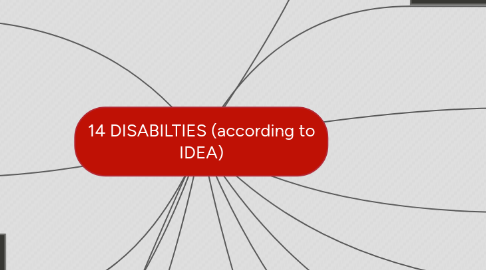14 DISABILTIES (according to IDEA)
por Sheela Rao


1. AUTISM
1.1. characteristics often associated with autism
1.1.1. repetitive activities and stereotyped movements
1.1.2. resistance to environmental change
1.1.3. unusual responses to sensory experiences
1.2. MODIFICATIONS: focus on improving communication, social, academic, behavioral, and daily living skills.
1.3. asisstive technology: picture communication board http://autismspectrumdevelopment.weebly.com/uploads/6/2/6/9/6269165/3244696.png?425
1.4. Case study: http://www.parentcenterhub.org/repository/autism/#story
2. DEAF-BLINDNESS
2.1. Modification: small group or individual instruction
2.2. Case Study: http://www.med.unc.edu/ahs/clds/resources/deaf-blind-model-classroom-resources/db-case-studies/matthews-story-1
2.3. Assistive Technology: Alphabet Flip Chart http://www.med.unc.edu/ahs/clds/images/db-images/wwap-snapshots/flip.jpg
3. OTHER HEALTH IMPAIRMENT
3.1. Modification: Planning for the safety of the child in school
3.2. Assistive Technology: Automatic Timed Medicine Dispenser
3.3. Accomodation: can stand and work, break down lessons
3.4. Example: ADHD, asthma, diabetes,epilepsy
4. SPECIFIC LEARNING DISABILITY
4.1. TYPES: Dyslexia, Dyscalcula, Dysgraphia
4.2. Accomodations: Large Print Text
4.3. Assistive Technology: Reading Pen http://citadel.sjfc.edu/students/scm03254/e-port/msti%20260/102474835d.jpg
4.4. Case Study: http://www.parentcenterhub.org/repository/ld/#story
5. TRAUMATIC BRAIN INJURY
5.1. Characteristics
5.1.1. Trouble remembering things
5.1.2. Emotional, social. behavioural problems
5.2. Intervention: Functional Behavioral Assessment
5.3. Assistive Technology: Adapted Pencil Grips http://www.especialneeds.com/images/C/pencilsGrips-cat-01-01.jpg
6. VISUAL IMPAIRMENT, INCLUDING BLINDNESS
6.1. Accomodations: Increased lighting
6.2. Assistive Technology: Braille n Speak http://www.edb.utexas.edu/atlab/Clipart/devicepics/BrailleNSpeak.jpg
7. SPEECH OR LANGUAGE IMPAIRMENT
7.1. Accomodation: Allowing more time, reduce distractions
7.2. Assistive Technology: Augmentative and Alternative Communication (AAC) http://creativesolutionsforhope.com/wp-content/uploads/2013/04/speech4.png
8. DEAFNESS
8.1. Characteristics
8.1.1. does not respond consistently to sounds
8.1.2. delayed in developing speech or has unclear speech
8.2. Accomodation: favorable seating in the class to facilitate lip reading
8.3. assistive technology: sign language
9. DEVELOPMENTAL DELAY
9.1. Intervention: Developmental Evaluation
9.2. Assistive Technology: Voice Output box
10. EMOTIONAL DISTURBANCE
10.1. Characteristics
10.1.1. Hyperactivity
10.1.2. Aggression
10.1.3. Withdrawal
10.1.4. Immaturity

